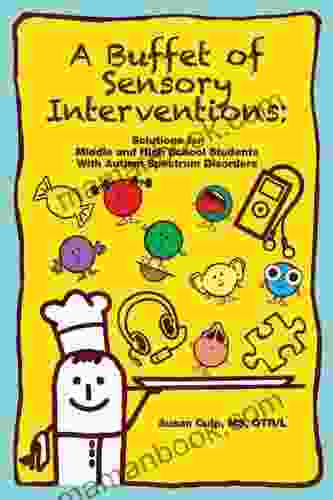Buffet of Sensory Interventions: A Comprehensive Guide to Enhancing Sensory Processing

Our senses are a vital part of our everyday lives, allowing us to interact with our environment and experience the world around us. For individuals with sensory processing challenges, however, everyday experiences can be overwhelming or understimulating, affecting their ability to participate fully in daily activities.
4.7 out of 5
| Language | : | English |
| File size | : | 3711 KB |
| Text-to-Speech | : | Enabled |
| Screen Reader | : | Supported |
| Enhanced typesetting | : | Enabled |
| Word Wise | : | Enabled |
| Print length | : | 150 pages |
Sensory interventions are a type of therapy that can help individuals with sensory processing challenges improve their ability to process sensory information. These interventions can be used to address a variety of sensory needs, including:
- Sensory modulation: Helping individuals regulate their level of arousal and response to sensory input.
- Sensory discrimination: Improving individuals' ability to distinguish between different sensory stimuli.
- Sensory integration: Helping individuals combine information from different sensory systems to create a more coherent picture of the world.
There is a wide range of sensory interventions available, and the best approach will vary depending on the individual's needs. Some common sensory interventions include:
- Sensory diets: A plan that provides individuals with regular opportunities to experience sensory input in a controlled and structured way.
- Sensory rooms: Specially designed environments that provide individuals with a variety of sensory experiences.
- Sensory activities: Activities that are designed to stimulate or calm the senses.
- Occupational therapy: A type of therapy that helps individuals develop skills for everyday living, including sensory processing.
Sensory interventions can be beneficial for individuals of all ages, from infants to adults. They can help to improve a variety of skills, including:
- Attention and focus
- Social skills
- Motor skills
- Self-regulation
- Overall well-being
If you are concerned about your child's sensory processing, talk to your doctor or occupational therapist. They can assess your child's needs and recommend appropriate sensory interventions.
Sensory Diets
A sensory diet is a plan that provides individuals with regular opportunities to experience sensory input in a controlled and structured way. Sensory diets can be used to address a variety of sensory needs, including:
- Sensory modulation: Helping individuals regulate their level of arousal and response to sensory input.
- Sensory discrimination: Improving individuals' ability to distinguish between different sensory stimuli.
- Sensory integration: Helping individuals combine information from different sensory systems to create a more coherent picture of the world.
Sensory diets can include a variety of different activities, such as:
- Proprioceptive activities: Activities that provide deep pressure input, such as jumping, crashing, or rolling.
- Vestibular activities: Activities that provide movement input, such as swinging, spinning, or bouncing.
- Tactile activities: Activities that provide touch input, such as playing with playdough, finger painting, or getting a massage.
- Auditory activities: Activities that provide sound input, such as listening to music, playing with musical instruments, or engaging in auditory discrimination games.
- Visual activities: Activities that provide visual input, such as looking at pictures, playing with light, or engaging in visual discrimination games.
The specific activities that are included in a sensory diet will vary depending on the individual's needs. A sensory diet should be developed by an occupational therapist or other qualified professional.
Sensory Rooms
Sensory rooms are specially designed environments that provide individuals with a variety of sensory experiences. Sensory rooms can be used to address a variety of sensory needs, including:
- Sensory modulation: Helping individuals regulate their level of arousal and response to sensory input.
- Sensory discrimination: Improving individuals' ability to distinguish between different sensory stimuli.
- Sensory integration: Helping individuals combine information from different sensory systems to create a more coherent picture of the world.
Sensory rooms typically include a variety of different sensory equipment, such as:
- Bubble machines: Provide visual and auditory stimulation.
- Crash mats: Provide proprioceptive and vestibular stimulation.
- Fiber optic lights: Provide visual stimulation.
- Music players: Provide auditory stimulation.
- Weighted blankets: Provide proprioceptive stimulation.
Sensory rooms can be a valuable tool for helping individuals with sensory processing challenges. They can provide a safe and controlled environment for individuals to explore their sensory needs and develop coping mechanisms.
Sensory Activities
Sensory activities are activities that are designed to stimulate or calm the senses. Sensory activities can be used to address a variety of sensory needs, including:
- Sensory modulation: Helping individuals regulate their level of arousal and response to sensory input.
- Sensory discrimination: Improving individuals' ability to distinguish between different sensory stimuli.
- Sensory integration: Helping individuals combine information from different sensory systems to create a more coherent picture of the world.
There are a wide range of sensory activities available, including:
- For proprioceptive input: Jumping, crashing, rolling, playing with playdough, finger painting.
- For vestibular input: Swinging, spinning, bouncing, riding a bike.
- For tactile input: Playing with sand, water, slime, shaving cream, or other tactile materials.
- For auditory input: Listening to music, playing with musical instruments, engaging in auditory discrimination games.
- For visual input: Looking at pictures, playing with light, engaging in visual discrimination games.
Sensory activities can be done at home, school, or in a variety of other settings. It is important to find activities that are enjoyable and appropriate for the individual's sensory needs.
Occupational Therapy
Occupational therapy is a type of therapy that helps individuals develop skills for everyday living, including sensory processing. Occupational therapists can assess an individual's sensory needs and develop a treatment plan that includes appropriate sensory interventions.
Occupational therapy can help individuals with sensory processing challenges improve their ability to:
- Regulate their level of arousal and response to sensory input
- Discriminate between different sensory stimuli
- Integrate information from different sensory systems to create a more coherent picture of the world
- Participate in everyday activities
Occupational therapy can be beneficial for individuals of all ages, from infants to adults. It can help to improve a variety of skills, including attention and focus, social skills, motor skills, self-regulation, and overall well-being.
Sensory interventions can be a valuable tool for helping individuals with sensory processing challenges. They can help to improve sensory regulation, discrimination, integration, and overall well-being. There is a wide range of sensory interventions available, and the best approach will vary depending on the individual's needs.
If you are concerned about your child's sensory processing, talk to your doctor or occupational therapist. They can assess your child's needs and recommend appropriate sensory interventions.
4.7 out of 5
| Language | : | English |
| File size | : | 3711 KB |
| Text-to-Speech | : | Enabled |
| Screen Reader | : | Supported |
| Enhanced typesetting | : | Enabled |
| Word Wise | : | Enabled |
| Print length | : | 150 pages |
Do you want to contribute by writing guest posts on this blog?
Please contact us and send us a resume of previous articles that you have written.
 Top Book
Top Book Novel
Novel Fiction
Fiction Nonfiction
Nonfiction Literature
Literature Paperback
Paperback Hardcover
Hardcover E-book
E-book Audiobook
Audiobook Bestseller
Bestseller Classic
Classic Mystery
Mystery Thriller
Thriller Romance
Romance Fantasy
Fantasy Science Fiction
Science Fiction Biography
Biography Memoir
Memoir Autobiography
Autobiography Poetry
Poetry Drama
Drama Historical Fiction
Historical Fiction Self-help
Self-help Young Adult
Young Adult Childrens Books
Childrens Books Graphic Novel
Graphic Novel Anthology
Anthology Series
Series Encyclopedia
Encyclopedia Reference
Reference Guidebook
Guidebook Textbook
Textbook Workbook
Workbook Journal
Journal Diary
Diary Manuscript
Manuscript Folio
Folio Pulp Fiction
Pulp Fiction Short Stories
Short Stories Fairy Tales
Fairy Tales Fables
Fables Mythology
Mythology Philosophy
Philosophy Religion
Religion Spirituality
Spirituality Essays
Essays Critique
Critique Commentary
Commentary Glossary
Glossary Bibliography
Bibliography Index
Index Table of Contents
Table of Contents Preface
Preface Introduction
Introduction Foreword
Foreword Afterword
Afterword Appendices
Appendices Annotations
Annotations Footnotes
Footnotes Epilogue
Epilogue Prologue
Prologue Trevor Clinger
Trevor Clinger Mark Twain
Mark Twain Zach Sears
Zach Sears Sarah Gailey
Sarah Gailey Sarah Elisabeth Sawyer
Sarah Elisabeth Sawyer Dirk Cussler
Dirk Cussler Nolan L Cabrera
Nolan L Cabrera Jinx Schwartz
Jinx Schwartz Lami Kamikaze
Lami Kamikaze Tom Teller
Tom Teller Michael C Grumley
Michael C Grumley Debra Kayn
Debra Kayn Stephen C Kucko
Stephen C Kucko Jimmy Moncrief
Jimmy Moncrief Nalini Singh
Nalini Singh Jason Whittle
Jason Whittle Keisuke Itagaki
Keisuke Itagaki Gary Golio
Gary Golio L Wilder
L Wilder Jesse Fox
Jesse Fox
Light bulbAdvertise smarter! Our strategic ad space ensures maximum exposure. Reserve your spot today!

 Israel BellHow to Move From Where You Are to Where You Want to Be: A Comprehensive Guide...
Israel BellHow to Move From Where You Are to Where You Want to Be: A Comprehensive Guide...
 Fletcher MitchellHow to Bury Curious Girl: An In-Depth Guide to Nurturing Curiosity in Girls
Fletcher MitchellHow to Bury Curious Girl: An In-Depth Guide to Nurturing Curiosity in Girls
 Jorge Luis BorgesA Mother's Heartbreaking Journey Through Grief, Suicide, and the Path to Hope...
Jorge Luis BorgesA Mother's Heartbreaking Journey Through Grief, Suicide, and the Path to Hope... Eddie BellFollow ·12.2k
Eddie BellFollow ·12.2k Jamal BlairFollow ·3.6k
Jamal BlairFollow ·3.6k Isaac BellFollow ·16.4k
Isaac BellFollow ·16.4k Jamie BlairFollow ·8k
Jamie BlairFollow ·8k Darrell PowellFollow ·5.1k
Darrell PowellFollow ·5.1k Eric HayesFollow ·6.5k
Eric HayesFollow ·6.5k Yasushi InoueFollow ·19.2k
Yasushi InoueFollow ·19.2k Denzel HayesFollow ·4k
Denzel HayesFollow ·4k

 Ernest Powell
Ernest PowellBenefits of Corporal Punishment: A Review of the...
Corporal punishment is a form of physical...

 Bobby Howard
Bobby HowardThe Development and Significance of African American...
African American...

 Guy Powell
Guy PowellDown Girl: The Logic of Misogyny - A Comprehensive...
In her groundbreaking work,...

 Forrest Blair
Forrest BlairThe Bikini Changing Room: A Micro Mini Romance
In the heart of...
4.7 out of 5
| Language | : | English |
| File size | : | 3711 KB |
| Text-to-Speech | : | Enabled |
| Screen Reader | : | Supported |
| Enhanced typesetting | : | Enabled |
| Word Wise | : | Enabled |
| Print length | : | 150 pages |










